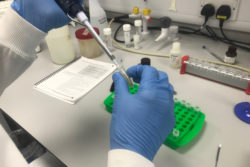Project details: Dust Bunny
Aims
To develop an understanding of the home as a source of infection of AMR bacteria carried by dust, by exploring hygiene practices across different home environments in Ghana, with the ultimate aim to reduce bacterial infection in the home environment thereby reducing AMR.
Objectives:
- Identify the current local hygiene practices and how the diversity of dust-born bacteria in different home environments in Ghana is driven by hygiene practices.
- Establish how different household beliefs between ‘dust’ and ‘germs’, and between ‘cleanliness’ and ‘hygiene’ impact on domestic hygiene practices.
- Consider how to best make safe hygiene practices parts of daily routine that are sustained by social norms through co-design activities.
- Validate and disseminate the proposed hygiene practices through consultation and dissemination with key stakeholders.
Methods
 The Dust Bunny project combined design and microbiology methods in an innovative mixed-method approach; a traditional survey design, a design ethnography, a cultural probe and a microbiological analysis were planned to provide insights for co-design workshops in which new cleaning practices might be developed to minimise any AMR bacteria present in the home environments in the Greater Accra Region of Ghana.
The Dust Bunny project combined design and microbiology methods in an innovative mixed-method approach; a traditional survey design, a design ethnography, a cultural probe and a microbiological analysis were planned to provide insights for co-design workshops in which new cleaning practices might be developed to minimise any AMR bacteria present in the home environments in the Greater Accra Region of Ghana.
The procession of methods; from survey instrument to design ethnography and cultural probe, made in parallel with a m icrobiological analysis, was designed to provide a range of insights into contemporary cleaning practices in Accra. These insights were then to be used by participants to co-design, in a one-day workshop, ‘new’ cleaning practices for a thirty-day intervention, which would be followed by another round of microbiological analysis. Plans, however, rarely survive an encounter with reality, and though the structure of the research design survived mostly intact, the deployments of some of the individual methods were subject to extensive change.
icrobiological analysis, was designed to provide a range of insights into contemporary cleaning practices in Accra. These insights were then to be used by participants to co-design, in a one-day workshop, ‘new’ cleaning practices for a thirty-day intervention, which would be followed by another round of microbiological analysis. Plans, however, rarely survive an encounter with reality, and though the structure of the research design survived mostly intact, the deployments of some of the individual methods were subject to extensive change.
